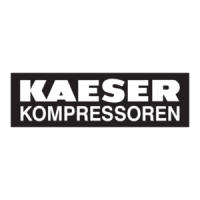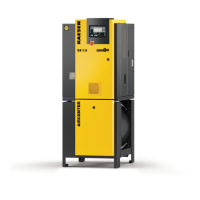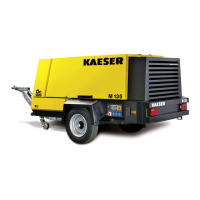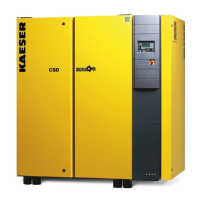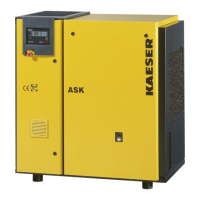Do you have a question about the KAESER SM 7.5 and is the answer not in the manual?
| Model | SM 7.5 |
|---|---|
| Category | Air Compressor |
| Motor Power | 7.5 kW |
| Voltage | 400 V |
| Frequency | 50 Hz |
| Tank Capacity | 270 L |
Guidance on how to use the operator manual effectively and keep it up-to-date.
Lists additional documentation provided with the operator manual.
Information regarding the copyright protection of this service manual.
Explanation of symbols, warning notices, and other labels used in the document.
Details about the machine's nameplate and its importance for identification.
Lists and describes the optional features available for the machine.
Specifies the maximum weight of the machine, dependent on fitted equipment.
Provides temperature specifications for cut-in, operation, and shutdown.
Defines permissible ambient conditions including elevation, temperature, and humidity.
Details on ventilation requirements, including inlet aperture and forced ventilation.
Specifies working pressure and safety relief valve activating pressures.
Provides free air delivery specifications at various working pressures.
Information on the function of cooling oil and recommendations for KAESER lubricants.
Specifies the required cooling oil volume for standard machines and with heat recovery.
Details on the compressor motor's rated power, enclosure, and rated speed.
Provides noise emission levels for the compressor models.
Basic requirements and considerations for the electrical power supply.
Detailed specifications for power supply connections, including wire sizes and fuses.
Provides heat capacity data for machines with the heat recovery option.
Fundamental safety principles and awareness of operational dangers.
Defines the intended industrial use of the machine and liabilities for misuse.
Outlines consequences of improper usage, including damage and injury.
Details user obligations regarding regulations, personnel, and maintenance schedules.
Identifies various sources of danger during operation and maintenance.
Information on safety devices and the importance of not altering them.
Specifies the designed working life of safety-relevant components.
Illustrates and explains the meaning of safety signs on the machine.
Provides guidance on correct fire fighting and treating injuries from cooling oil.
Details warranty terms, conditions, and exclusions.
Guidance on protecting the environment during operation and disposal.
Overview of the machine's enclosure and its functions.
Explanation of the machine's operational flow and component interactions.
Lists and describes the machine's safety devices and their functions.
Details machine operating modes (STOP, READY, LOAD, IDLE) and control modes.
Overview of the SIGMA CONTROL 2 operating panel, including keys and indicators.
Information on floating relay contacts for signal transfer.
Description of available machine options, such as machine mountings and heat recovery.
Safety precautions and requirements for machine installation.
Guidelines for determining location, clearances, and machine room ventilation.
Considerations for operating the machine within a compressed air system.
Safety instructions for performing installation work on the machine.
Procedure for reporting any visible or hidden transport damage.
Instructions for connecting the machine to the compressed air system.
Guidance on connecting an external pressure transducer to the machine.
Steps for making the electrical power supply connection, including voltage selection.
Details on installing machine options like anchorings and heat recovery systems.
Safety precautions for commissioning and initial start-up procedures.
Measures for re-commissioning after storage and initial commissioning checks.
Checklist for confirming correct installation and operating conditions before starting.
Guidance on setting the overload protection relay for motor starting.
Procedure for adding cooling oil to the airend before initial start-up.
Instructions for activating and deactivating the MODULATING control feature.
Step-by-step guide for the initial start-up and operation of the machine.
Procedure for adjusting the system's set point pressure for optimal operation.
Verification of the door interlock switch function for safety.
Instructions on how to change the display language on the controller.
Procedures for safely switching the machine on and off using the control panel.
Using the EMERGENCY STOP button and restarting the machine after an emergency stop.
Operating the machine remotely via a control center connection.
Instructions for utilizing the timer function for automatic machine operation.
Understanding and interpreting operational messages displayed by the controller.
Procedure for acknowledging and clearing alarm and warning messages.
General guidance on identifying and rectifying machine faults.
Troubleshooting table for common faults and their possible causes and remedies.
Safety precautions to be taken before and during maintenance work.
Guidance on logging maintenance, resetting counters, and performing regular tasks.
Procedure for cleaning or renewing filter mats for the cooler.
Instructions for cleaning or renewing filter mats in the control cabinet.
Regular cleaning of the cooler to ensure reliable operation and prevent leaks.
Procedure for maintaining the external heat recovery system.
Steps for performing maintenance on the air filter element.
Information on compressor motor bearing maintenance.
Instructions for checking and adjusting the drive belt tension.
Procedure for testing the functionality of the safety relief valve.
Verification of the machine's safety shutdown function for overheating.
Procedure for testing the EMERGENCY STOP push button.
How to check the cooling oil level using the sightglass.
Steps for safely venting the machine to remove internal pressure.
Procedure for topping off the cooling oil and performing a trial run.
Detailed steps for draining and changing the machine's cooling oil.
Instructions for replacing the oil filter.
Procedure for replacing the oil separator cartridge.
Guidance on logging all maintenance and service tasks performed.
Importance of the nameplate for identifying the machine and ordering parts.
Information on ordering genuine KAESER consumable parts and fluids.
Overview of services offered by KAESER AIR SERVICE.
Information on locating KAESER service representatives.
Guidance on planning material requirements and ordering spare parts.
Procedures for temporary and long-term decommissioning of the machine.
Instructions for packing the machine for transport, including material requirements.
Considerations for storing the machine to prevent corrosion and damage.
Safety measures and methods for transporting the machine, including forklift and crane.
Guidelines for the proper disposal of the machine and its components.
P+I diagrams illustrating the machine's process flow.
P+I diagram specifically for the MODULATING control mode.
Technical drawings showing machine dimensions and connection points.
Schematic diagrams illustrating the machine's electrical system.
